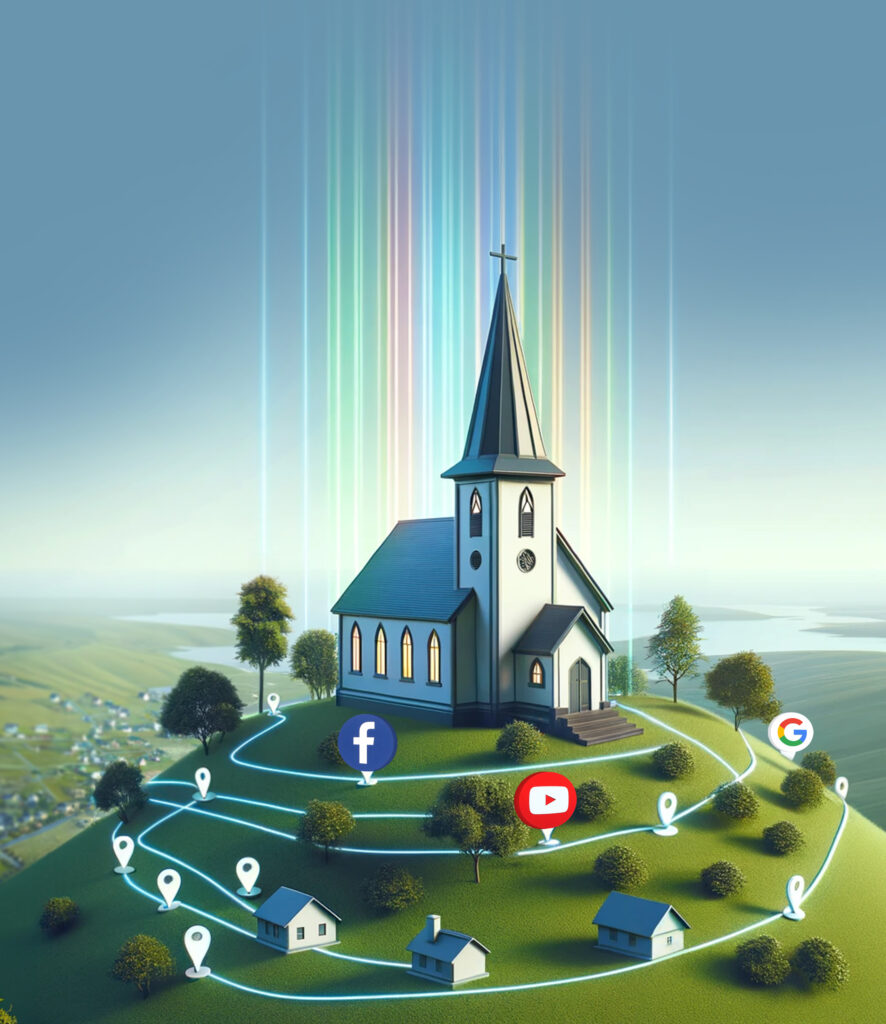
Technology has changed how we interact with the physical world. Yet despite all of the technological advances, people still need human connection. So how do you create connections and build trust in a society that has less and less experience with church?
By evaluating current trends, churches can adapt to a rapidly changing societal landscape and consider new approaches to fulfill their mission of sharing the love and teachings of Jesus Christ. If we take a thoughtful and multi-dimensional approach that recognizes the importance of embracing digital tools and strategies in the modern context, we can effectively reimagine how a church can “go” and spread the Good News today’s digital world and make disciples in their local communities.
What are current trends telling us?

1. Church attendance is dropping nationally.
The decline in church attendance can be attributed to various factors, including changing cultural norms and evolving attitudes toward organized religion, spirituality, and communal worship. The availability of digital platforms and social media has transformed how younger generations access information, and differing perspectives on the importance of church in people’s lives are emerging.
It’s crucial to recognize that the decline in church attendance is a complex and multifaceted trend shaped by individual and collective factors. While this trend poses challenges, it also presents opportunities for churches to adapt, engage with diverse audiences, and explore innovative ways to connect with those seeking spiritual fulfillment and community involvement.

2. People are less likely to go out as they used to.
The likelihood of people going out to events or places has fluctuated over time and is influenced by factors such as cultural shifts, technology, personal economic conditions, and health considerations. The emergence of digital delivery options, the rise of streaming services, and the convenience of virtual experiences have provided alternative social engagement and reduced in-person activities for many individuals.
However, we are all still human, and the desire for social interaction and community remains strong, motivating people to seek new experiences, connections, and enrichment through events and places. The key is it has to be truly meaningful to get them to go out.

3. People spend more time on electronic devices.
It is well-documented that as society increasingly turns to electronic devices for communication and entertainment, there has been a noted decline in face-to-face interactions and the development of rich, in-person communities. Research has indicated a decrease in the amount of time individuals spend engaging in close proximity, human-to-human interactions, has been linked to an increase in feelings of anxiety and loneliness. Additionally, there is evidence of a gradual erosion of basic social skills, including the ability to maintain sustained eye contact during conversations, as a result of the shift towards digital communication.
Consequently, individuals who experience anxiety and loneliness may turn even more to their electronic devices for comfort and companionship, further perpetuating a cycle of reliance on technology as a source of solace in the absence of fulfilling in-person connections.
How do we reach people online?
We can navigate these challenges by offering something that every human is longing for: trust and connection. We just need to do it through the digital avenues that will actually reach them. And that is where intentional digital marketing strategies come in.
At SermonView, we take a multi-touch marketing approach as often as we can when helping churches reach their communities.
There are several key ways a multi-touch digital marketing approach can have a positive impact on reaching more people and building trust with your ministry.
Here are the top 4 benefits:

Increased Exposure:
Consistently running ads across different channels not only increases visibility, but it also creates “brand recognition” for your church. People are more likely to take notice and remember your church name or events when they encounter multiple touchpoints, leading to higher awareness and engagement. Multiple touchpoints enable churches to reinforce its messaging and serve as reminders to potential event attendees. With each interaction, the event details, attendance benefits, and relevance are reiterated, increasing the chances of participants taking action and pre-registering for the event or engaging with another call to action.
Audience Targeting:
A multi-touch approach allows churches to leverage more channels with different messages to target multiple specific audiences. For example, social media ads can target users based on their demographics and interests, while your email marketing efforts can be personalized and sent to those who have already taken the first step and given you their contact information. This enables you to deliver tailored messages to various segments of your audience, increasing the likelihood of attracting people at each stage of their journey with your church.
Diversification:
Reduce your reliance on a single channel or platform, so you aren’t just shouting one message in one direction and hoping everyone hears it. This mitigates the risk of missed opportunities due to changes in algorithms, changes in user behavior, or technical issues with a specific platform. It provides you with a broader foundation for communication, ensuring consistent, widespread outreach throughout the year.
Tracking and Optimization:
By employing a multi-touch approach, a church can track the effectiveness of each marketing effort and evaluate which touchpoints are most successful in driving interactions, connections, pre-registrations, event or even Sabbath attendance. You can even use this data to tailor your messaging to pre-registrations without attendance vs. pre-registrations with attendance. This data-driven approach allows for ongoing optimization and refinement of your marketing strategies for connecting with your unique community God has called you to reach.
Can A Church Really Build Trust Through Marketing?
So we need to meet people where they are at, both physically and spiritually, to help them become comfortable with the idea of church, and digital marketing can do that. Sounds easy enough, but we are faced with a deluge of information online every day, how can a church cut through the noise? There are several theories about how many times someone needs to see an ad before they take action. The problem is this number varies depending on the context, industry, and target audience.
Plus, we aren’t talking about quick fix, “secular solutions” like the rest of our consumer-driven culture uses to handle numbing personal, spiritual issues. There is no singular answer to how long it takes each heart to respond to the Holy Spirit, so there is no cookie cutter formula. The Holy Spirit’s job is to convict, our job is just to go and tell. So let’s make sure that we are in a position to spread the good news as much as we can to those in our community that we can physically meet with.
Here is one example of how a church might approach applying a multi-touch marketing strategy to their mission to reach their community throughout the year:

Facebook/Instagram
- Paid Ad Campaign:
- Offer Bible studies or event invitations to a targeted audience outside your follower base.
- Church Account:
- Share inspiration through Bible verses, sermon snippets, member testimonials, etc. to your followers and for public display should someone manually look up your church account.

YouTube
- Paid Ad Campaign:
- Build brand awareness and develop a parasocial relationship through personalized videos throughout the year:
- Offer prayer, inspiration, encouragement, personal growth challenges, invitations to events, etc. (For more information about building a parasocial relationship, check out The Digital Transformation of Ministry.)
- Build brand awareness and develop a parasocial relationship through personalized videos throughout the year:

- AdWord Campaigns:
- Drive traffic by using links to specific landing pages (these can be articles or videos with an opportunity to ask for more information) on your outreach-focused website. These are tied to your church’s fundamental beliefs while still speaking to common felt needs:
- Landing page ideas: Prayer Request, Importance of Rest (Sabbath), What Happens When We Die? (State of the dead), Starting a healthy lifestyle (benefits to a vegetarian/caffeine free lifestyle), etc.
- Drive traffic by using links to specific landing pages (these can be articles or videos with an opportunity to ask for more information) on your outreach-focused website. These are tied to your church’s fundamental beliefs while still speaking to common felt needs:
- Google Reviews:
- Get your church members to review your church on Google. Never underestimate the power of a good testimony. This is an easy way to get more people involved and drive up your church’s reputation online.
This is just one example of a multi-touch marketing strategy a church could adopt. What matters is repeated exposure, across multiple platforms, and actively studying the frequency to maintain the effectiveness of your efforts throughout the year.
Best (secular) marketing practices suggests the“Rule of Seven”: that a consumer needs to encounter an ad approximately seven times to take action, as repeated exposure builds familiarity and trust. However, it is not an absolute rule and can vary. Another popular concept, that perhaps works better to cut through the digital noise of today is “Effective Frequency”: This focuses on fine-tune management to find the optimal number of ad exposures to achieve specific marketing goals, considering multiple factors like target audience, the objectives of each of your ads (inspiration, prayer request, event invitation, etc.), and the creative being advertised.
Trust takes time, and it takes trust to build connections.
Increasing your exposure while building trust over time and in multiple places is crucial to maintaining a steady, successful marketing campaign that is targeted to reach more people in your unique area. With a targeted, intentional approach, churches can utilize digital media marketing to build connections within their community and lead more people to a lasting relationship with Jesus.

Next-generation digital advertising to reach this generation.
At SermonView, we have helped churches with over 6,000 outreach events. We’ve sent over 30 million mailers into communities and reached over 8 million social media users. So we know how to help you plan an effective campaign.

